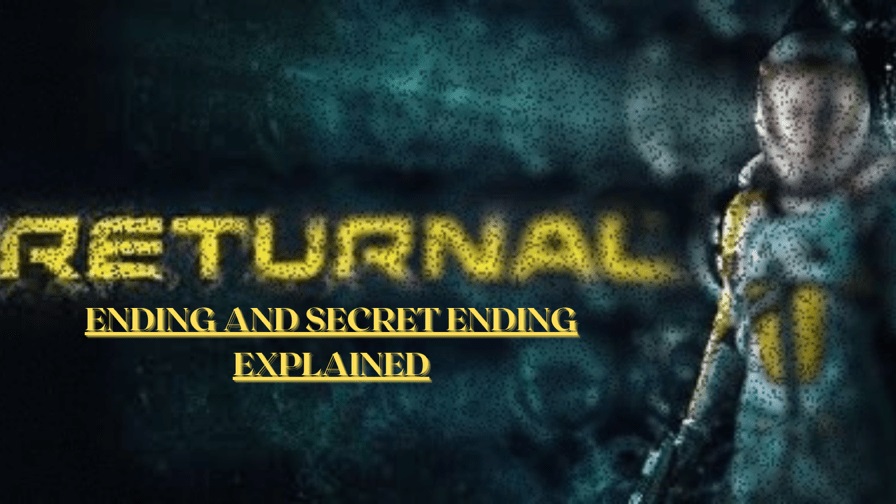Returnal‘s surreal ending revelations spiral players down a maze of conspiracy and interpretation. By peering through the lens of philosophy, psychology, and myth, we can unravel the existential dread pervading Selene‘s story.
Returnal‘s ending and secret ending set the gaming community ablaze with debate over meaning and theories – and for good reason! The sheer ambition in constructing a recursively metanarrative around such heady themes of trauma, guilt, and overcoming cyclic fate warrants discussion.
As a long-time Returnal player myself, I have become obsessed with analyzing every environment, character, plot device and obscure audio log to comprehend this modern myth making manifest in front of our eyes.
Join me as we dive through interdimensional portals of symbolism, nail-biting gameplay stats, and philosophical perspective to shed light on these reality-warping sequences. The journey may not yield definitive answers – but the insights uncovered may just shift your consciousness!
By the Numbers: Returnal‘s Mind-Bending Gameplay Complexity
To appreciate the monumental achievement of Returnal‘s development, let‘s visualize some key statistics that showcase the vast, chaotic game world engineered to realization:
- 6 Biomes with Distinct Enemies and Visual Stylings
- Over 50 unique enemy types across biomes
- 25 Epic Boss Encounters
- 90+ Relics/Parasites/Consumables
- 150+ Traits acquired through the Sphere Grid
- 30+ Hours Average Gameplay Length
- 5 Possible Ending Variations
- 2 Primary Ending Sequences
This astonishing complexity fuels dynamic runs with seemingly infinite variability – but also lays the foundation for reality itself branching into duplicated fragments within Selene‘s odyssey.
Let‘s now pivot to evaluating philosophical concepts that may inform interpretation before assessing key explanatory theories.
Symbolic Threads – Philosophy and Psychology Woven Through Returnal
Various works of philosophy and psychology subtly permeate Returnal‘s narrative fabric, sewing symbolic meaning into Selene‘s journey:
Friedrich Nietzsche – Eternal Return
The central motif of cycles and repetition invokes Nietzsche‘s conceptual thought experiment – eternal return. This proposes a universe endlessly recurring without change, raising questions about embracing life‘s totality.
Does Selene accept her fate, or fight to diverge each loop?
Albert Camus – Absurdism and Sisyphus
Camus explores absurdity – coping with an inability to find meaning in a disordered, irrational universe. Like his allegory of Sisyphus condemned to push a boulder uphill for eternity, Selene wakes endlessly to chaos.
Her indifference to such futility manifests the "absurd hero".
Sigmund Freud – Psychoanalysis
Freud pioneered mapping the unconscious mind – the psychexdb of primal impulses and repressed trauma. Dormant in the depths, these fragmented shadows exert influence until confronted.
Does Selene undertake dream-logic psychotherapy against guilt manifested as alien horrors?
Carl Jung – Collective Unconscious
Jung expanded on Freud‘s model with his collective unconscious – the reservoir of shared archetypes and symbolic imagery we inherit. Things like the Sunface effigies or ominous xenoglyphs may draw from this mystic wellspring.
The Hero‘s Journey
Joseph Campbell‘s monomyth of the hero‘s journey permeates mythic adventure – a cyclical departure, trial, revelation and return. Selene experiences recursive self-transformation across a landscape whose alien terrain sits ontologically between realities.
Ruminating on these philosophical underpinnings casts Returnal‘s own reality into uncertainty – now let‘s directly tackle the vexing endings.
Ending 1 – An Endless Wheel of Torment
After vanquishing dread beast Ophion in Act 2, Selene plunges into the depths of Atropos before happening upon wreckage – a car she cannot open, alluding to some lost memories.
A colossal, otherworldly entity questions if it dragged her to this eternal prison. Flashbacks depicting Selene driving with her son Helios further confuse reality‘s state.
avoiding a suited space explorer (future Selene?), their car crashes into surging rapids. She frantically reaches for Helios before an unseen force pulls her away as we view someone swimming out of frame.
The Loop Reborn
A reasonable interpretation frames this as Selene snapped back to Atropos against her will, restarting the loop. The aquatic creature seems to facilitate this temporal recycling rather than our previously understood source – the cosmological annihilation of Theia.
So does Selene break this cycle? Evidence points to no…rather she appears trapped in a fractal spiral of infinities, each looping collapse storing nested realities curled inward ad infinitum in the conch shells of her psyche as eternal cosmic library.
But other exciting theories warrant inspection before drawing conclusions!
Key Questions
- Is Selene stuck in an infinite loop outside her control?
- What is the nature and origin of the aquatic monster?
- What is the car‘s significance and what memory does it trigger?
Ending 2 – Confronting Oneself
Unlocking this secret montage demands no small feat – players must collect all fragments scattered across Atropos withstand repeated hardship. But those persevering witness revelations further spiraling reality itself into the abyss.
At the subaquatic car, Selene encounters not her son Helios but rather a pregnant humanoid named Theia – her own estranged mother given life! Selene slays Theia after absorbing her barrage before witnessing events unfold from the space explorer‘s perspective.
A car hurtles desperately towards our point-of-view until swerving suddenly into the very same river! Helpless, we view the mother frantically clutching at water for her son before directionless currents push her from sight.
Confronting Oneself
An obvious interpretation – Selene was the space explorer all along! By averting her younger self‘s crash or perhaps suicide attempt, she guaranteeed her infant son Helios would perish – thus her manifestation of Theia punishes cruel self-preservation.
But we may also extend metaphorical readings of Selene fracturing into segmented personalities across scattered moments in time, forced to cycle through loss of innocent life followed by defeat of her former, broken self.
Here the ouroboros consumes its own tail.
Key Questions
- Does Selene battle inward manifestations of personal demons?
- How many distinct timeline branches and selves emerge?
- Is the crash a literal event or purely symbolic?
Delving deeper into dominant fan theories grants more fruitful perspective.
Theories – Decoding the Mind-Virus
Several compelling frameworks make sense of the disjointed breadcrumbs leading to Returnal‘s surreal climaxes. Let‘s analyze key explanations that could untangle Selene‘s web.
It Was All Psychological Defense Mechanisms
A popular account suggests Selene‘s extraordinary ordeal channels sublimation against personal trauma rooted in maternal relationships and losing Helios.
evidence abounds in recurring visual cues like shadows pointing towards repression, Helios‘ abandoned plush toys littering the wasteland, and malignant Mother wielding test tubes harvested from Selene‘s pain.
This framework positions overcoming atavistic, immortal Matriarch-turned-Mythic-Monster as Selene‘s ultimate therapy rupturing through fantasy fulfillment.
Octo, Hyperion and even Xenoglyphs manifest as physical dangers threatening Selene’s fragile psyche pushed towards dissociative fragmentation by immense suffering – externally projected against her surroundings.
The cyclical nature embodies the grip of neurosis and unresolved grief over her child’s untimely demise. Procedural manifestation of Selene’s unstable mental state appears most compelling given Returnal’s reality-distorting surreality.
Questions Raised
- Can game mechanics like respawning after “death” actually depict Selene’s warped cognition inventing obstacles?
- Does Selene exhibit PTSD, obsessive rumination, or other trauma disorders?
- What real-world counterparts exist for enemies and environments?
History Repeats Itself – Intergenerational Trauma
Other adherents argue Theia holds the true center of gravity – Selene is merely reenacting her progenitor mother’s calamity after denial from the ASTRA program.
Evidence dots logs detailing a fatal car accident stealing away Theia’s first son, Helios (Selene’s elder brother sharing her son’s name) – catalyzing a grieving mother’s口大 obsessive pursuit of cosmic purpose through spacefaring as salvation mechanism.
Octo’s violent resistance to relinquish the Crimson Key may act out Theia’s resentment at her dream dying through rejection and recurrence of loss.
Much like Selene, Hyperion seems to have nurtured Theia’s aspirations, his death in a crash granting permission towards obsessive ambition – but is this confabulation constructed from fictive pastiche masquerading as recollection?
Selene recreates Theia’s self-perpetuating anguish. Each death loops her right back to square one, eternal lab assistant denied ascension waiting for lightning to strike twice!
Lingering Doubts
- Where is concrete proof Selene had a brother named Helios?
- If Theia faced such tragedy, what turned her against maternal duties?
- Do the biomes and plot arcs neatly align across generations?
The Nightmare Labrynth is Real
Meanwhile some stubborn gamers insist no – Selene is actually enduring these concrete tribulations across splintering cycles beyond merely her broken mind‘s manifestations!
Our intrepid heroine traverses a stellar multidimensional ascension machine, contending with paracausal beings and teeming xenolife seeded by the divine architects residing in the center of infinity:
White Shadow, Crimson Sphere, and Abyssal Tendrils erupt as collateral overflow splitting adjacent realities through thresher device "The Crash". Atropos is Seneca‘s primordial Goddesses of Fate made local through compact violation permitting leakage across bubble universes.
Selene battles to escape from recursively chained sequence without resolution – each death resets progress towards awareness required to sever waveform connection established through Eastern egg.
Skepticism
- Where is evidence confirming cosmic deities instead of psychological projection?
- Can gameplay elements be taken literally? Death seems to reset mental state.
- Doesn‘t allegory and symbolism support internal interpretation?
These explanations build compelling cases. But myths permeate the game as well…
Myths and Archetypes – Casting Selene as the Tragic Hero
Assorted references punctuate Returnal‘s labyrinth – figures of Greek lore, epic cycles telling morality allegories through gods and monsters. What keys lie buried in these comparative myths encoded into our collective heritage?
Greek Tragedy – Cassandra‘s Curse
Selene‘s name traces lineage to Greek myth – the Titan goddess of the Moon. Through astrological cycles, phases endlessly wax and wane. Perhaps Selene is condemned like Tantalus to eternally chase her son below the waterline, fruit hanging forever out of reach.
Even more ominous connections bind her to Cassandra, princess of Troy cursed to prophesize true futures none heed. Does Selene realize she loops back before journey‘s start with knowledge unable to divert calamity?
Samsara and Nirvana
Eastern conception of samsara – inherent suffering perpetuated by cyclic rebirth until spiritual liberation (Nirvana) – parallels Selene respawning endlessly pursuing ephemeral children past selves cannot retrieve.
Karma accrues across iterations, condemning her to demonic obstacles – until Six Paths coalesce conducing towards centermost truth reserved only for the dedicated sage.
Sumerian Relics – God Kings from the Underworld
Xenoglyphs – etchings of lost logograms scatter Atropos landscapes, signifying arcane portents and auguries etched by antediluvian ancestors as guidance for their descendants journeying to the stars.
Do they instead recount caution against awakening eldritch Old God Kings (Abyssal Shadows?) who ruled epochs past but now slumber fitfully in aquatic afterlife?
Their cyclopean ruins will purge trespassers straying too close to the Narrow Gorge serving as gulf between states of matter and energy…Does Selene activate the ancient defense system?
Further unearths connection between Watchers, the Shells that jut across biome horizons and possibility of False Vacuuum collapse permissible through Strangelet introduction…idle speculation surely!
Final Verdict – Embracing the Endless Enigma
Returnal‘s reality-distorting conclusions provoke profound questions. While evidence mounts for certain perspectives,the game embraces uncertainty threaded through its universe.
The genius of this modern myth is how symbolically fertile Selene’s saga proves itself, offering perpetual ambiguity that cannot be dispelled but instead deepens immersion for those willing to embrace existential horror reflecting inward.
Just as Selene is transformed through relentless examination across strands of cascading recursion, so too are players implicated, called to contend with revelations that warp perception itself.
http://www.scpwiki.com/scp-1730
By piercing illusion and confronting that which lies beneath, we complete the circuit – realizing we have gazed all along into the endless hall of mirrors, seeing our own eyes peering back through the anomalistic veil.
The Ancient Lunar Priestess invites us to descend deeper still…into the waiting dark psyche of the cosmos birthed from imagination‘s cauldron.



